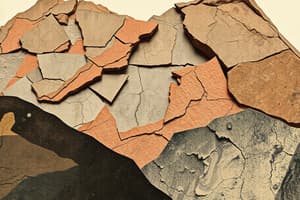Podcast
Questions and Answers
What are the three major classes of metamorphic rocks?
What are the three major classes of metamorphic rocks?
Contact metamorphism, pressure metamorphism, and regional metamorphism.
How does the texture of metamorphic rocks relate to their mineral composition?
How does the texture of metamorphic rocks relate to their mineral composition?
The texture is determined by the types of minerals present, particularly lamellar minerals in foliated rocks.
What is the primary mineral composition of basalt, and how does it form?
What is the primary mineral composition of basalt, and how does it form?
Basalt is comprised mainly of magnesium and iron-rich minerals and forms from the rapid cooling of mafic lava.
Describe the QAPF classification in relation to granite.
Describe the QAPF classification in relation to granite.
What is the significance of foliation in metamorphic rocks?
What is the significance of foliation in metamorphic rocks?
What are the uses of basalt in construction?
What are the uses of basalt in construction?
Explain the formation process of granite.
Explain the formation process of granite.
Why is granite considered a suitable material for pavements?
Why is granite considered a suitable material for pavements?
What are the primary minerals that compose limestone?
What are the primary minerals that compose limestone?
How does sandstone resist weathering compared to other rock types?
How does sandstone resist weathering compared to other rock types?
What is orthoquartzite and what is its significance?
What is orthoquartzite and what is its significance?
What process primarily leads to the formation of limestone?
What process primarily leads to the formation of limestone?
Why is limestone prone to damage from acid rain?
Why is limestone prone to damage from acid rain?
How does marble differ from limestone in terms of formation?
How does marble differ from limestone in terms of formation?
What is the main use of marble in construction?
What is the main use of marble in construction?
What notable feature does Ashgabat, Turkmenistan have regarding marble?
What notable feature does Ashgabat, Turkmenistan have regarding marble?
What are granitoids and their significance in the continental crust?
What are granitoids and their significance in the continental crust?
Describe the process of sedimentation in the formation of sedimentary rocks.
Describe the process of sedimentation in the formation of sedimentary rocks.
What is the predominant type of sedimentary rock, and what percentage does it constitute?
What is the predominant type of sedimentary rock, and what percentage does it constitute?
What are the primary classifications of sedimentary rocks based on grain size?
What are the primary classifications of sedimentary rocks based on grain size?
What characterizes the layer formation of sedimentary rocks?
What characterizes the layer formation of sedimentary rocks?
Explain the metamorphism process and its effect on original rocks.
Explain the metamorphism process and its effect on original rocks.
What percentage of the Earth's crust is made up of sedimentary rocks?
What percentage of the Earth's crust is made up of sedimentary rocks?
What is the significance of fossils in sedimentary rocks?
What is the significance of fossils in sedimentary rocks?
Flashcards are hidden until you start studying
Study Notes
Metamorphic Rocks
- Comprise 27.4% of the Earth's crust by volume.
- Divided into three classes: contact metamorphism, pressure metamorphism, regional metamorphism.
- Texture is influenced by the types of minerals, with foliated rocks mainly containing lamellar minerals.
- Common examples include schists, gneiss, slates, phyllites, mylonite, marble, soapstone, and serpentine.
Basalt
- Aphanitic (fine-grained) extrusive igneous rock, formed from rapid cooling of low-viscosity mafic lava.
- Significant volcanic rock type observed in approx. 20 volcanoes annually across the Solar System.
- Used in construction, cobblestone production, and to create statues.
- Can be heated and extruded to produce stone wool, an effective thermal insulator.
Granite
- Coarse-grained (phaneritic) intrusive igneous rock composed primarily of quartz, alkali feldspar, and plagioclase.
- Forms from silica and alkali metal oxide-rich magma that cools underground.
- Classifications based on QAPF, indicating varying percentages of quartz and feldspar.
- Often contains mica or amphibole; leucogranites contain minimal dark minerals.
- Resilient and porous, making granite suitable for pavement material.
Sandstone
- Composed mainly of quartz or feldspar; colors vary based on regional influences.
- Known for weathering resistance, used historically in construction and decorative arts.
- Orthoquartzite, a pure quartz sandstone with 90-95% quartz content, proposed for Global Heritage Stone Resource nomination in Argentina.
Limestone
- Carbonate sedimentary rock primarily made of calcite and aragonite minerals.
- Forms through the precipitation of calcium minerals from water, with significant biological processes over the last 540 million years.
- Represents 20%-25% of sedimentary rock, predominantly limestone with some dolomite.
- Acts as a raw material for lime production but is vulnerable to acid rain, necessitating preservation efforts.
Marble
- Metamorphic rock made of calcite or dolomite, characterized by a crystalline texture without foliation.
- Originates from metamorphosed limestone and is used in stonemasonry for sculpture and construction.
- Notable example includes Tennessee marble; Ashgabat, Turkmenistan, has the highest concentration of white marble buildings.
Sedimentary Rocks
- Formed at Earth's surface through accumulation and cementation of rock fragments, minerals, and organic materials.
- Characterized by processes of sedimentation, compaction, and cementation (diagenesis).
- Classified by grain size: clay, silt, sand, gravel; also includes cobbles and boulders.
- Comprise about 7.9% of the crust; 82% constitutes shales, with 6% limestone and 12% sandstone and arkoses.
- Commonly contain fossils and are deposited in horizontal layers, known as stratified rocks.
General Notes on Metamorphism
- Metamorphic rocks arise from any rock type subjected to high temperatures and pressures leading to a change in form.
- This process transforms physical properties and chemistry, often occurring during continental plate collisions.
Studying That Suits You
Use AI to generate personalized quizzes and flashcards to suit your learning preferences.




